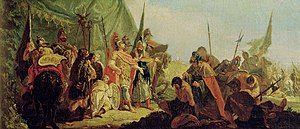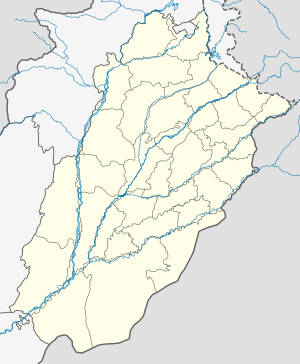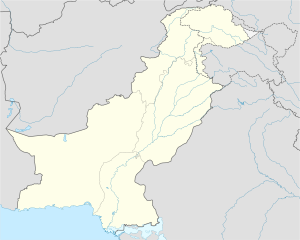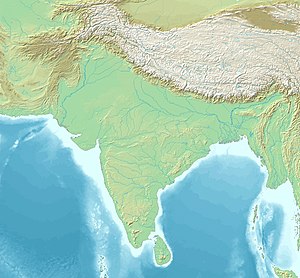
Back معركة هيداسبس Arabic هوداسپس دؤیوشو AZB Битка при Хидасп Bulgarian Bitka kod Hidaspa BS Batalla del riu Hidaspes Catalan Bitva u Hydaspés Czech Schlacht am Hydaspes German Μάχη του Υδάσπη Greek Batalo de Hidaspo Esperanto Batalla del Hidaspes Spanish
| Battle of the Hydaspes | |||||||||
|---|---|---|---|---|---|---|---|---|---|
| Part of Alexander's Indian campaign | |||||||||
 Alexander the Great and Porus by Francesco Fontebasso | |||||||||
| |||||||||
| Belligerents | |||||||||
|
Macedonian Empire Hellenic League Gandhara | Pauravas[1] | ||||||||
| Commanders and leaders | |||||||||
| |||||||||
| Strength | |||||||||
|
45,000–47,000 total |
22,000–54,000 total | ||||||||
| Casualties and losses | |||||||||
|
~1,000 total[12] | |||||||||
The Battle of the Hydaspes also known as Battle of Jhelum, or First Battle of Jhelum, was fought between Alexander the Great and Porus in May of 326 BCE. It took place on the banks of the Hydaspes River in what is now the Punjab province of Pakistan,[17] as part of Alexander's Indian campaign. In what was possibly their most costly engagement,[18] the Macedonian army secured a decisive victory over the Pauravas and captured Porus.[e] Large areas of Punjab were subsequently absorbed into the Macedonian Empire; Porus was reinstated as the region's ruler after Alexander, having developed a newfound respect for the fierce resistance put up by Porus and his army, appointed him as a satrap.
Despite close surveillance by the Pauravas, Alexander's decision to cross the monsoon-swollen Hydaspes to catch Porus' army in the flank has been called one of his "masterpieces" in combat.[20] The Macedonians' engagement with the Indians at Hydaspes remains a very significant historical event during the Wars of Alexander the Great, as it resulted in the exposure of Greek political and cultural influences to the Indian subcontinent, which would continue to affect Greeks and Indians for centuries to come.
After the battle, Alexander continued his eastward march into modern-day India, intending to cross the Ganges River.[21] However, he stopped at the Hyphasis (now called the Beas) in 326 BC[21] after his weary troops refused to advance further, having campaigned with him for nearly eight years.[22][23] Arms and armor were also wearing out, and there was concern within the army that they could meet disaster in India.[23] The Hyphasis marked the farthest advance of Alexander in India, and upon leaving, he "left King Porus in charge of this easternmost territory."[23]
- ^ Graham Phillips (31 March 2012). Alexander The Great. Ebury Publishing. pp. 129–131. ISBN 978-0-7535-3582-0.
- ^ Green 1991, p. 402.
- ^ Cite error: The named reference
Arrian 5.14was invoked but never defined (see the help page). - ^ Fuller estimates a further 2,000 cavalry under Craterus' command.
- ^ Harbottle, Thomas Benfield (1906). Dictionary of Battles. New York.
- ^ a b Plutarch 62.1:"But this last combat with Porus took off the edge of the Macedonians' courage, and stayed their further progress into India. For having found it hard enough to defeat an enemy who brought but twenty thousand foot and two thousand horse into the field..."
- ^ a b c Arrian, 5.15
- ^ a b Diodorus, 17.87.2
- ^ Green 1991, p. 553.
- ^ Curtius 8.13.6; Metz Epitome 54 (following Curtius)
- ^ Plutarch 60.5
- ^ Roy 2004, pp. 19–23.
- ^ a b c Arrian, 5.18
- ^ a b Cite error: The named reference
Diodorus 17.89.3was invoked but never defined (see the help page). - ^ According to Fuller 1960, p. 199, "Diodorus' figures appear more realistic."
- ^ Cite error: The named reference
Diodorus 17.89.1-3was invoked but never defined (see the help page). - ^ Locke, Ralph P. (2016). "Alexander the Great and the Indian Rajah Puru. Exoticism in a Metastasio Libretto As Set by Hasse and by Handel". Revue de Musicologie. 102 (2): 275–317. ISSN 0035-1601. JSTOR 44739484.
The elephants of Puru's army were overwhelmed by the Greeks' horses in 326 BC on the left bank of the Hydaspes, a river - also known as the Jhelum or Jhelam - that is located in what is today Pakistan
- ^ Peter Connolly. Greece and Rome At War. Macdonald Phoebus Ltd, 1981, p. 66
- ^ Brice 2012, p. 81.
- ^ Burn 1965, p. 150
- ^ a b Mark, Joshua J. "Alexander the Great". World History Encyclopedia. Archived from the original on 12 November 2024. Retrieved 22 November 2024.
- ^ "The Empire and Expeditions of Alexander the Great". World Digital Library. 1833. Retrieved 26 July 2013.
- ^ a b c Mathew, Philip. "The Hyphasis Mutiny". World History Encyclopedia. Archived from the original on 13 July 2024. Retrieved 22 November 2024.
Cite error: There are <ref group=lower-alpha> tags or {{efn}} templates on this page, but the references will not show without a {{reflist|group=lower-alpha}} template or {{notelist}} template (see the help page).



